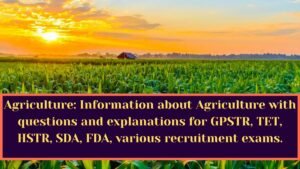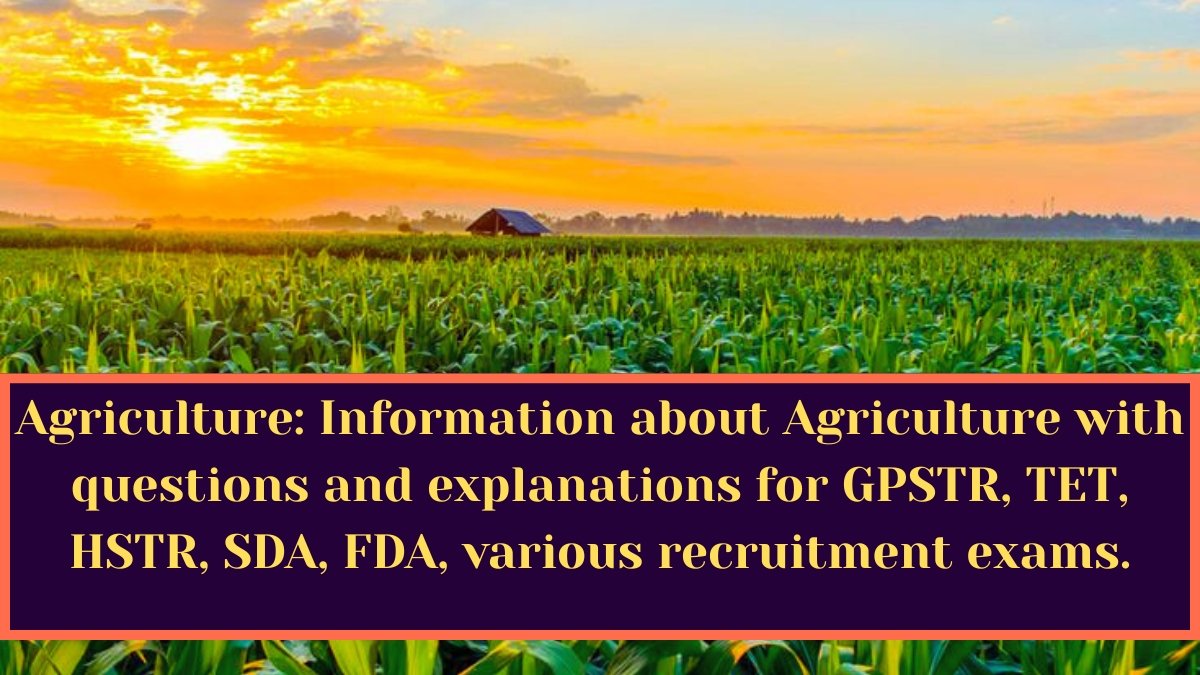Agriculture: Information about Agriculture with questions and explanations for GPSTR, TET, HSTR, SDA, FDA, various recruitment exams.

1. Which Indian State is the leading cotton producer ?
1) Gujarat
2) Maharashtra
3) Andhra Pradesh
4) Madhya Pradesh
Ans:-1) Gujarat
• Gujarat is a major cotton growing state.
• Maharashtra has the largest area devoted to cotton cultivation in the country. Gujarat, Maharashtra, Andhra Pradesh, Telangana, Haryana, Karnataka.
• Suitable soil for cotton crop is Black / Regar soil. (Black soil is called cotton soil).
• Environment required for growing cotton: Time Required: 6 to 8 months ~ 21° C-30° C, 2 : 50 000 100, •
• India has the largest cotton growing area in the world. But it is second only to China in production.
• India’s first Bt (Bacillus Thuringiensis) strain: cotton
—————————————————
2. The most ideal region for the cultivation of coffee in India is the
1) Indo-Gangetic Valley
2) Brahmaputra Valley
3) Rann of Kutch
4) Deccan Plateau
Ans:- 4) Deccan Plateau
• Deccan plateau is suitable for coffee cultivation in India.
• Karnataka, Kerala and Tamil Nadu are the traditional coffee growing regions of South India. These three regions of India produce the entire coffee grown in India.
• Geographic factors for coffee cultivation:
• temperature – 15°C to 28°C
• the rain – 150-250 Cm
• height – 600 00 1600 2 (on the slopes of the hills)
• The largest coffee producing countries are Brazil, Colombia, Indonesia, Ethiopia, Mexico followed by India at 7th position.
• In India :-1) Karnataka (71%)2) Kerala (21%) 3) Tamil Nadu (5%)
—————————————————————————-
3. Blue Revolution is related to
1) Fish production
2) Milk production
3) Oil production
4) Food production
Ans:- 1) Fish production
• Blue revolution refers to aquaculture or fish farming.
• Blue revolution started in India during 1973 2002. Its fathers are: Dr|| Arun Krishnan and Dr. Harilal Chaudhary
—————————————————————————-
4. In India, ‘Yellow revolution’ is associated with
1) production of paddy
2) production of oilseeds
3) production of tea
4) production of flower
Ans:- 2) production of oilseeds
• Growth, development and adoption of new varieties of oilseeds and complementary technologies doubled the production of oilseeds from 12.6mt in 1987-88 to 24.4mt in 1996-97.
• This was the Yellow Revolution, a technological advancement on oilseeds.
• The oilseeds production scenario in India is witnessing growth.
• With an annual production of around 11 million tonnes from oilseed crops till 1986-87, the country achieved ‘self-sufficient and net exporter’ status from ‘net importer’ status in the early nineties.
• In just over a decade, an all-time record oilseed production of 25 million tonnes was achieved from annual oilseed crops during 1996-97.
• This development was called the “Yellow Revolution”. Father of Yellow Revolution : Sam Pitroda.
——————————————————————————-
5. Which of the following are not grown in the Kharif season?
1) Bajra and rice
2) Maize and jowar
3) Barley and mustard
4) Jowar and rice
Ans:- 3) Barley and mustard
• Kharif crops are usually sown during the southwest monsoon with the onset of the first rains in July.
• Common Kharif Crops:- Millet, Maize, Green Cereals, Sugarcane, Pigeon Pea, Pulses, Groundnut, Sunflower, Soybean, Paddy, etc.
—————————————————————————–
6. Kerala is famous for the cultivation of
1) Coconut
2) Black-pepper
3) Rubber
4) Rice
Ans:- 1) Coconut
• Kerala is a major producer of commercial plantation crops like coconut, rubber, pepper, cardamom, ginger, cashew nut, areca nut, coffee etc.
• “Kerala” means the land of coconuts.
• Kerala accounts for the majority of India’s coconut production.
• Kerala is the largest producer of pepper and natural rubber in India.
• India ranks fourth in natural rubber production and second in world consumption.
• Kerala accounts for more than 90 percent of the country’s total rubber production.
• Thailand is the leading rubber producing country in the world.
——————————————————————————-
7. ‘Brown Revolution’ is
1) Growth of fodder industry
2) Growth of sea products.
3) Growth of milk and milk products
4) Growth of food processing and soft drinks industries in India
Ans:- 4) Growth of food processing and soft drinks industries in India
—————————————————————————
8. Mechanization of Indian agriculture on a considerable scale is not possible due to –
1) Small holdings
2) Lack of tractors
3) Poverty of the peasants
4) Indifference of the people
Ans:- 1) Small holdings
• Indian agriculture cannot be mechanized on a substantial scale due to small holdings.
• Small holdings are mainly due to land fragmentation.
——————————————————————————
9. Golden Revolution refers to
1) Sericulture
2) Horticulture
3) Apiculture
4) viticulture
Ans:- 2) Horticulture
• Production of horticultural crops has now given more importance leading to ‘Golden revolution’.
• It has been called the Golden Revolution as it could earn huge foreign exchange by exporting fruits, vegetables and flowers.
• India has already made great strides in the production of fruits and vegetables, ranking second only to China in the world.
——————————————————————————-
10. Which of the following is not a cause of low productivity in Indian agriculture?
1) Co-operative farming
2) Inadequate inputs availability
3) Sub-division and fragmentation of land holdings
4) Poor finance and marketing facilities.
Ans:- 1) Co-operative farming
• Productivity is actually a function of efficiency & effectiveness. Both are essential for manufacturing industry.
• Indian agriculture sector is less productive due to traditional farming methods;
• lack of adequate machinery; lack of finance for farmers; Lack of good quality seeds and fertilizers and ownership of land,
• Moreover, increasing population pressure on land is a major demographic factor leading to low yields in agriculture.
• Lack of finance, marketing and storage facilities is also responsible for agricultural backwardness in India.
• Cooperatives and corporate agencies have not been able to stop the moneylenders in the village.
• Storage facilities are still not available to the farmers to preserve their farm produce for better price.
————————————————————————–
Agriculture: Information about Agriculture with questions and explanations for GPSTR, TET, HSTR, SDA, FDA, various recruitment exams.

11. Which of the following is called “brown paper”?
1) Jute
2) Cotton
3) Rubber
4) Tea
Ans:- 1) Jute
• This rich textured brown paper is made from malleri tissue with bits of jute or manila jute spread across the sheet.
• (Jute: Corchorus Capsularis)
• 0.48% of India’s cultivated area is grown in the field. Sand mixed with clay and alluvial soil is best suited for this crop.
• Jute is called the Golden Thread of Bengal.
• First jute industry:- Established in 1855 at Rishra in Bengal province by British merchant George Akand and Bengali moneylender Babu Baisumber Sen. It was established on the banks of river Hooghly.
——————————————————————————
12. India is the largest producer of
1) Cotton
2) Rice
3) Mica
4) Tea
Ans:- 3) Mica
• Mica :- India produces about 90% of the world’s mica. It is an indispensable aspect of power industry. It is a non-metallic mineral found in igneous and metamorphic rocks.
• States with mica:- Andhra Pradesh, Maharashtra, Jakarta, Odisha, Rajasthan, etc.
• State-wise total resource distribution of mica is as follows:- Andhra Pradesh has 41% share. Rajasthan (21%) of the country’s total resources.
——————————————————————————
13. India is The largest producer of Lac in
1) Chhattisgarh
2) Jharkhand
3) West Bengal
4) Gujarat
Ans:- 2) Jharkhand
• Jharkhand is the major producer of lac, followed by Chhattisgarh, West Bengal and Maharashtra.
• Lac is the reddish resinous secretion of several species of lac insects.
• Among them, the most commonly cultivated species is Keria lakka.
——————————————————————————-
14. The most ideal region for the cultivation of cotton in India is
1) The Brahmaputra Valley
2) The Deccan Plateau
3) The Indo Gangetic Valley
4) The Rann of Kutch
Ans:- 2) The Deccan Plateau
• Dabban Plateau is considered the most suitable region for cotton cultivation in India.
• The lava soil of Dabban Plateau is world famous for cotton production. It is popularly known as black cotton soil.
• It is found in the central part of the Dabban Plateau, which includes parts of Maharashtra, Gujarat and Chhattisgarh, Madhya Pradesh, Andhra Pradesh and Karnataka.
• Black soil is known as regur soil.
—————————————————————————–
15. Which state is rich in jute?
1) West Bengal
2)Tamil Nadu
3) Kerala
4) Orissa
Ans:- 1) West Bengal
• Jute is one of the most important natural fibers after cotton in terms of cultivation and consumption.
• About 85% of the world’s jute cultivation is concentrated in the Gangetic Delta. Its cultivation depends on climate, season and soil. This fertile geographical area is shared by both Bangladesh & India (West Bengal).
• West Bengal occupies the leading position in both jute area (73.5%) and production (82.26%) in the country. Here the crop is cultivated throughout the state except the hilly region in the north and the plateau region in the west. And jute is called “golden fiber”.
—————————————————————————-





